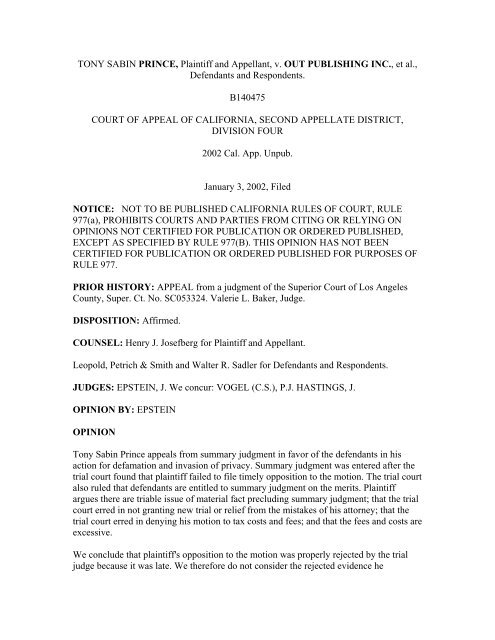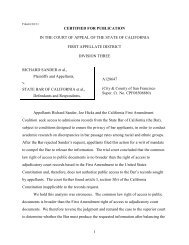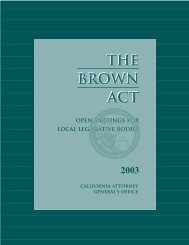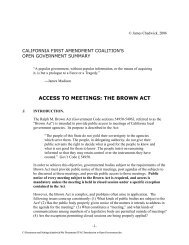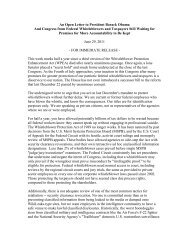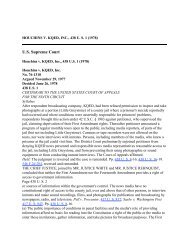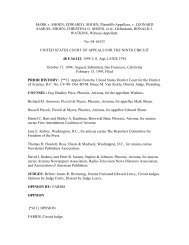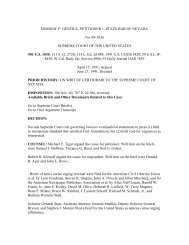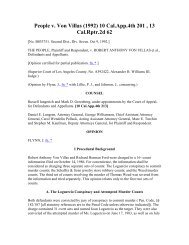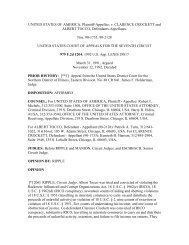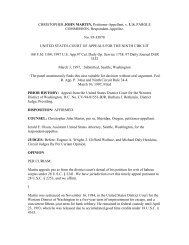TONY SABIN PRINCE, Plaintiff and Appellant, v. OUT PUBLISHING ...
TONY SABIN PRINCE, Plaintiff and Appellant, v. OUT PUBLISHING ...
TONY SABIN PRINCE, Plaintiff and Appellant, v. OUT PUBLISHING ...
Create successful ePaper yourself
Turn your PDF publications into a flip-book with our unique Google optimized e-Paper software.
<strong>TONY</strong> <strong>SABIN</strong> <strong>PRINCE</strong>, <strong>Plaintiff</strong> <strong>and</strong> <strong>Appellant</strong>, v. <strong>OUT</strong> <strong>PUBLISHING</strong> INC., et al.,<br />
Defendants <strong>and</strong> Respondents.<br />
B140475<br />
COURT OF APPEAL OF CALIFORNIA, SECOND APPELLATE DISTRICT,<br />
DIVISION FOUR<br />
2002 Cal. App. Unpub.<br />
January 3, 2002, Filed<br />
NOTICE: NOT TO BE PUBLISHED CALIFORNIA RULES OF COURT, RULE<br />
977(a), PROHIBITS COURTS AND PARTIES FROM CITING OR RELYING ON<br />
OPINIONS NOT CERTIFIED FOR PUBLICATION OR ORDERED PUBLISHED,<br />
EXCEPT AS SPECIFIED BY RULE 977(B). THIS OPINION HAS NOT BEEN<br />
CERTIFIED FOR PUBLICATION OR ORDERED PUBLISHED FOR PURPOSES OF<br />
RULE 977.<br />
PRIOR HISTORY: APPEAL from a judgment of the Superior Court of Los Angeles<br />
County, Super. Ct. No. SC053324. Valerie L. Baker, Judge.<br />
DISPOSITION: Affirmed.<br />
COUNSEL: Henry J. Josefberg for <strong>Plaintiff</strong> <strong>and</strong> <strong>Appellant</strong>.<br />
Leopold, Petrich & Smith <strong>and</strong> Walter R. Sadler for Defendants <strong>and</strong> Respondents.<br />
JUDGES: EPSTEIN, J. We concur: VOGEL (C.S.), P.J. HASTINGS, J.<br />
OPINION BY: EPSTEIN<br />
OPINION<br />
Tony Sabin Prince appeals from summary judgment in favor of the defendants in his<br />
action for defamation <strong>and</strong> invasion of privacy. Summary judgment was entered after the<br />
trial court found that plaintiff failed to file timely opposition to the motion. The trial court<br />
also ruled that defendants are entitled to summary judgment on the merits. <strong>Plaintiff</strong><br />
argues there are triable issue of material fact precluding summary judgment; that the trial<br />
court erred in not granting new trial or relief from the mistakes of his attorney; that the<br />
trial court erred in denying his motion to tax costs <strong>and</strong> fees; <strong>and</strong> that the fees <strong>and</strong> costs are<br />
excessive.<br />
We conclude that plaintiff's opposition to the motion was properly rejected by the trial<br />
judge because it was late. We therefore do not consider the rejected evidence he
proffered. We also conclude that defendants met their burden of establishing a right to<br />
summary judgment on the merits. The trial court did not err in denying plaintiff's motions<br />
for reconsideration <strong>and</strong> to vacate the judgment. The award of fees <strong>and</strong> costs was proper.<br />
FACTUAL AND PROCEDURAL SUMMARY<br />
<strong>Plaintiff</strong> is a working actor <strong>and</strong> model. Defendants are Out Publishing, Inc. (Out); Jeff<br />
Jacobson, a professional photographer; <strong>and</strong> James Collard <strong>and</strong> Louis M. Fabrizio, former<br />
employees of Out (collectively, the defendants). Out is no longer doing business. It<br />
formerly published Out Magazine, a monthly publication geared toward the gay<br />
community. The May 1998 issue featured an article written by Jesse McKinley entitled<br />
Dirty Dancing (the Article). The Article was about charges of improprieties at "circuit<br />
parties" including the use of illicit drugs <strong>and</strong> unsafe sexual practices. Jeff Jacobson took<br />
the photographs for the Article. The Article included three photographs of plaintiff. The<br />
first is a large two-page photograph at the beginning of the Article, showing plaintiff<br />
naked from the waist up dancing with another man. <strong>Plaintiff</strong>'s face <strong>and</strong> torso are seen in<br />
another photograph <strong>and</strong> his face alone appears again in a photographic montage. There<br />
are no captions for the first two photographs. The third photograph is one of two<br />
accompanying a photograph of circuit party promoter Jeffrey Sanker with the caption:<br />
"PARTY BOY: Circuit promoter Jeffrey Sanker (above) has had his share of<br />
controversy--but also roaring successes like Palm Springs' White Party kickoff (left), an<br />
East-meets-West collaboration with Twilo, the New York club."<br />
<strong>Plaintiff</strong> alleges that the photographs of him were actually taken in February 1998, when<br />
he attended a dance party called "Juniorverse" at a private club in Los Angeles. An<br />
advertisement for that party establishes that it was promoted by Jeffrey Sanker <strong>and</strong> Twilo,<br />
NYC. Advance tickets were available to the public for $ 40 from the Sporting Club or by<br />
telephone. Tickets at the door were $ 45. <strong>Plaintiff</strong> alleges that the photographs were taken<br />
without his permission <strong>and</strong> that the rules of the club at which the Juniorverse party was<br />
held forbade cameras <strong>and</strong> photography of the patrons. Juniorverse was a one-time dance<br />
event featuring a prominent disc jockey. The complaint alleges that there were full body<br />
searches at the door of the club to deter the use of drugs.<br />
<strong>Plaintiff</strong> alleges that the photographs used in the Article revealed his sexual orientation as<br />
a gay man for the first time to members of his family, professional associates, <strong>and</strong><br />
personal friends. The photographs, in combination with the Dirty Dancing caption <strong>and</strong><br />
the text of the Article allegedly "falsely portray him as a 'drug whore,' or a gay man who<br />
uses illegal, so-called recreational drugs such as Ecstasy, crystal methamphetamine<br />
('crystal') <strong>and</strong> gamma-hydroxy butyrate ('GHB'), <strong>and</strong> engages in wanton, unsafe sex at socalled<br />
'circuit parties,' such as the one in New York City discussed in the article."<br />
According to the complaint, the Article falsely implied that plaintiff attended the Saint-at-<br />
Large White Party <strong>and</strong> kickoff party at Twilo for the Palm Springs White Party. In fact,<br />
plaintiff does not use these drugs, does not engage in unsafe sex <strong>and</strong> did not attend either<br />
of these parties.<br />
Eleven days after publication of the Article, through an attorney, plaintiff dem<strong>and</strong>ed a
correction from Out. He also asserted that his likeness had been misappropriated. <strong>Plaintiff</strong><br />
dem<strong>and</strong>ed that the correction make it clear that the photographs of him were not taken at<br />
any circuit party, that they were taken without his knowledge or permission, <strong>and</strong> that he<br />
does not use drugs or engage in unsafe sex. <strong>Plaintiff</strong> also dem<strong>and</strong>ed $ 425,000 for the<br />
unauthorized use of defamatory photographs.<br />
Out published a correction in its June 1998 issue, at the end of the letters section. It read:<br />
"CLARIFICATION Photographs of dancers on pages 90-92, illustrating an article in the<br />
May issue entitled 'Dirty Dancing,' should have been labeled to indicate that they were<br />
taken at the Juniorverse party on February 15 at Arena, a Los Angeles club, <strong>and</strong> not at the<br />
White Party in Palm Springs, California, or the White Party in New York described in the<br />
story's opening paragraphs. In addition, the appearance of any specific individuals in<br />
those photographs is not intended to imply that they engage in any specific behaviors<br />
discussed in the article."<br />
<strong>Plaintiff</strong> filed his original verified complaint on July 10, 1998. The first amended verified<br />
complaint (the charging pleading), filed in October 1998, alleges causes of action for<br />
libel; invasion of privacy (false light); invasion of privacy (publication of private facts);<br />
invasion of privacy (unlawful intrusion); common law misappropriation; statutory<br />
misappropriation; <strong>and</strong> infliction of emotional distress. The record reflects that the seventh<br />
cause of action for infliction of emotional distress was dismissed by plaintiff without<br />
prejudice on October 2, 1998. We therefore do not address the arguments made by<br />
plaintiff regarding that cause of action.<br />
Defendants moved for summary judgment or in the alternative, for summary adjudication<br />
of the issues. <strong>Plaintiff</strong>'s opposition was due October 13, 1999. Five days after the<br />
opposition was due, on October 18, plaintiff's counsel made an ex parte application for a<br />
continuance of the hearing on the motion for summary judgment, because within two<br />
days he was going into the hospital for an extended period. The application was granted<br />
<strong>and</strong> the motion for summary judgment was continued to January 27, 2000. <strong>Plaintiff</strong>'s<br />
opposition to the motion was to be filed by January 13, 2000. (Code Civ. Proc., § 437c,<br />
subd. (b) [opposition due 14 days before hearing].) 1 On January 20, the trial court issued<br />
a tentative ruling on the motion for summary judgment, which was faxed to counsel for<br />
defendants. Defense counsel gave notice of the tentative ruling to counsel for plaintiff on<br />
January 21, 2000. The tentative ruling stated that the motion would be granted because<br />
there were no material factual disputes <strong>and</strong> defendants were entitled to judgment as a<br />
matter of law. The trial court noted that no opposition had been filed or served.<br />
- - - - - - - - - - - - - - Footnotes - - - - - - - - - - - - - - -<br />
1 All statutory references are to the Code of Civil Procedure unless otherwise<br />
indicated.<br />
- - - - - - - - - - - - End Footnotes- - - - - - - - - - - - - -<br />
<strong>Plaintiff</strong>'s memor<strong>and</strong>um of points <strong>and</strong> authorities; supporting declarations of Jesse
Dorado, Pamela Kay Apostolou <strong>and</strong> plaintiff; <strong>and</strong> a separate statement were filed<br />
the day before the hearing, on January 26, 2000. On the morning of the hearing,<br />
plaintiff filed a declaration by his counsel which was served on defense counsel, <strong>and</strong><br />
a "confidential declaration" lodged with the court <strong>and</strong> not served on defendants.<br />
Apparently these explained why counsel for plaintiff miscalendared the hearing date<br />
<strong>and</strong> said that the hard drive on plaintiff's counsel's computer had crashed on the<br />
night of January 23, 2000 as he was working on opposition to the motion for<br />
summary judgment. The declaration served on defendants attached various<br />
exhibits. On February 4, 2000, eight days after the trial court granted the motion for<br />
summary judgment, counsel for plaintiff lodged objections to the evidence in<br />
support of the motion for summary judgment.<br />
The trial court granted the motion for summary judgment on January 27. At the<br />
hearing, the trial court noted that it had just received the declaration of plaintiff's<br />
counsel. The judge also stated that she had received the opposition <strong>and</strong> supporting<br />
declarations at 3:45 the previous afternoon. She took them home <strong>and</strong> read them<br />
overnight. The trial court informed counsel for plaintiff that his confidential<br />
declaration would not be considered unless served on counsel for defendants. She<br />
offered to treat it as confidential <strong>and</strong> to seal the reporter's transcript of the hearing<br />
on the confidential declaration. The trial court noted that plaintiff had been served<br />
with the moving papers on September 27, 1999, <strong>and</strong> that a supplemental pleading<br />
was filed by the defendants on December 2, 1999. Earlier in the week of the hearing,<br />
the clerk of the court gave counsel for plaintiff a copy of the tentative ruling on the<br />
motion for summary judgment. Counsel for defendants said he still had not seen the<br />
opposition papers filed by plaintiff. The trial court recessed to read the late-filed<br />
papers from plaintiff.<br />
The trial court found insufficient grounds to consider the late-filed opposition<br />
papers, particularly because the moving papers were served on September 27,<br />
giving plaintiff's counsel nearly four months to prepare an opposition or to<br />
withdraw. The trial court granted the motion for summary judgment. The trial<br />
court also stated that even if the late opposition were considered, the ruling would<br />
be the same. Judgment was entered on January 31, 2000, in favor of defendants.<br />
<strong>Plaintiff</strong> brought two motions after judgment was granted to defendants: a motion<br />
to set aside or vacate the judgment, or in the alternative, for new trial, <strong>and</strong> a motion<br />
for reconsideration. Defendants opposed the motions. The trial court found no error<br />
of law or mistake which would justify vacation of the judgment or a new trial. But<br />
the court nevertheless went on to consider the merits of the motions <strong>and</strong> concluded<br />
that the judgment was correct because the opposition to the motion for summary<br />
judgment did not raise a triable issue of material fact.<br />
The parties litigated defendants' claim of costs <strong>and</strong> attorney's fees under Civil Code<br />
section 3344. The trial court awarded fees <strong>and</strong> costs of $ 75,362.04. <strong>Plaintiff</strong> filed a<br />
timely appeal from the judgment in favor of defendants.
DISCUSSION<br />
I<br />
The first issue is the impact of plaintiff's late opposition to the motion for summary<br />
judgment. Section 437c, subdivision (b) provides in pertinent part: "Any opposition to the<br />
motion shall be served <strong>and</strong> filed not less than 14 days preceding the noticed or continued<br />
date of hearing, unless the court for good cause orders otherwise." (See Hobson v.<br />
Raychem Corp. (1999) 73 Cal.App.4th 614, 624-625.) It is undisputed that plaintiff filed<br />
no opposition until the day before the hearing, <strong>and</strong> filed papers on the day of the hearing,<br />
in violation of this statutory deadline.<br />
A similar situation was presented in Thatcher v. Lucky Stores, Inc. (2000) 79 Cal.App.4th<br />
1081. In that case, the plaintiffs filed no opposition to a motion for summary judgment<br />
brought by the defendant. They filed an ex parte application for a continuance of the<br />
motion on the day of the hearing, on the ground their counsel had been ill <strong>and</strong> their<br />
investigators had not had an opportunity to complete their work. The trial court denied<br />
the continuance request <strong>and</strong> granted the summary judgment motion on the sole ground<br />
that plaintiffs had filed no opposition. ( Id. at p. 1084.) On appeal, the plaintiffs argued<br />
the trial court erred in denying their ex parte application for a continuance <strong>and</strong> in granting<br />
summary judgment based solely on their failure to file opposition, even though the<br />
defendant had not met its initial burden of proof. The Court of Appeal agreed that it is<br />
error to grant summary judgment on the sole basis of lack of opposition, because the<br />
moving party still must meet its initial burden of proof under section 437c in order to<br />
prevail. ( Id. at pp. 1085-1086.) But the Thatcher court went on to conclude that the<br />
defendant had met its initial burden of proof, <strong>and</strong> due to plaintiffs' failure to file<br />
opposition, summary judgment was proper. ( Id. at p. 1083.)<br />
The court found no abuse of discretion in denying plaintiffs' request for a continuance in<br />
light of their history of dilatory prosecution of the case, failure to respond to discovery,<br />
<strong>and</strong> delay in bringing the ex parte application for continuance until the day of the hearing<br />
on the summary judgment motion. The court concluded that the trial court was not<br />
required to continue the hearing because plaintiffs' request was not included in timely<br />
filed opposition as required by section 437c, subdivision (h). (Ibid.)<br />
Here, plaintiff obtained a substantial continuance of the deadline for filing opposition to<br />
the motion for summary judgment. Despite this extension, the opposition was not filed<br />
until just before the date set for the continued hearing. Because plaintiff violated section<br />
437c, subdivision (b) in filing late opposition papers, we do not consider his papers in<br />
deciding whether defendants established defenses to the action that entitle them<br />
to summary judgment. We do, however, determine whether the defendants met their<br />
initial burden of proof in support of their motion.<br />
II<br />
All of plaintiff's tort causes of action are based on the publication of photographs of
himself in the Article. Because of this, the First Amendment protection of the media is<br />
implicated. The primary issue in our First Amendment analysis is whether the use of<br />
plaintiff's likeness means that the Article was "of <strong>and</strong> concerning" him, a nexus he must<br />
establish. Insofar as plaintiff can be defamed by his likeness in the photographs, the<br />
Article is "of <strong>and</strong> concerning" him. But, as we discuss, the only aspect that is "of <strong>and</strong><br />
concerning" plaintiff is that he was at a party <strong>and</strong> that he is gay. As to this aspect of<br />
plaintiff's case, defendants have a complete defense to the libel causes of action: truth,<br />
since plaintiff acknowledges that he is in fact gay. <strong>Plaintiff</strong> is unable to establish that the<br />
references in the Article to unsafe sex <strong>and</strong> illegal drug use were "of <strong>and</strong> concerning" him,<br />
raising a First Amendment defense for the defendants.<br />
The California Supreme Court addressed the First Amendment defense <strong>and</strong> the "of <strong>and</strong><br />
concerning" requirement in Blatty v. New York Times Co. (1986) 42 Cal.3d 1033, 232<br />
Cal. Rptr. 542, 728 P.2d 1177 (Blatty): "The fundamental reason that the various<br />
limitations rooted in the First Amendment are applicable to all injurious falsehood claims<br />
<strong>and</strong> not solely to those labeled 'defamation' is plain: although such limitations happen to<br />
have arisen in defamation actions, they do not concern matters peculiar to such actions<br />
but broadly protect free-expression <strong>and</strong> free-press values. [Citation.]" ( Id. at p. 1043.) In<br />
Blatty, the court ruled that each cause of action was barred on First Amendment grounds<br />
because the plaintiff could not satisfy the "of <strong>and</strong> concerning" element. ( Id. at p. 1048.)<br />
If plaintiff cannot satisfy this requirement, defendants have established a defense to the<br />
action <strong>and</strong> are entitled to summary judgment.<br />
"In defamation actions the First Amendment also requires that the statement on which the<br />
claim is based must specifically refer to, or be 'of <strong>and</strong> concerning,' the plaintiff in some<br />
way. The New York Times [New York Times v. Sullivan (1964) 376 U.S. 254, 11 L. Ed.<br />
2d 686, 84 S. Ct. 710] case suggested as much, although it could possibly have been read<br />
to imply that the requirement derives from the due process clause of the Fourteenth<br />
Amendment <strong>and</strong> ultimately from the state's definition of the tort of defamation, <strong>and</strong> hence<br />
that it is merely an element which the state is presumably free to require or not as it sees<br />
fit. (376 U.S. at pp. 288-292 [11 L. Ed. 2d at pp 711-714].) Rosenblatt v. Baer (1966) 383<br />
U.S. 75 [15 L. Ed. 2d 597, 86 S. Ct. 669], however, made it plain that the requirement<br />
derives directly <strong>and</strong> ultimately from the First Amendment. In that case, the United States<br />
Supreme Court held that a defamation plaintiff could not constitutionally establish<br />
liability without satisfying the requirement even though the governing state law imposed<br />
no such prerequisite: 'under New York Times . . . [the plaintiff is] required to show<br />
specific reference.' ( Id. at p. 83 [15 L. Ed. 2d at p. 604], italics added, 86 S. Ct. at p.<br />
674.) [P] Although the limitations that define the First Amendment's zone of protection<br />
for the press were established in defamation actions, they are not peculiar to such actions<br />
but apply to all claims whose gravamen is the alleged injurious falsehood of a statement:<br />
'that constitutional protection does not depend on the label given the stated cause of<br />
action' (Reader's Digest Assn. v. Superior Court [(1984)] 37 Cal.3d [244] at p. 265), <strong>and</strong><br />
no cause of action 'can claim . . . talismanic immunity from constitutional limitations' . . .<br />
." ( Blatty, 42 Cal.3d at pp. 1042-1043, italics added.)<br />
The Blatty court examined the rationale for the "of <strong>and</strong> concerning" requirement: "The 'of
<strong>and</strong> concerning' or specific reference requirement limits the right of action for injurious<br />
falsehood, granting it to those who are the direct object of criticism <strong>and</strong> denying it to<br />
those who merely complain of nonspecific statements that they believe cause them some<br />
hurt. To allow a plaintiff who is not identified, either expressly or by clear implication, to<br />
institute such an action poses an unjustifiable threat to society." ( Blatty v. New York<br />
Times Co., supra, 42 Cal.3d at p. 1044.) In order to satisfy the "of <strong>and</strong> concerning"<br />
requirement, the plaintiff must establish that the statement at issue either expressly<br />
mentions him or refers to him by reasonable implication. ( Id. at p. 1046.)<br />
A<br />
We first consider whether plaintiff can satisfy the "of <strong>and</strong> concerning" requirement by the<br />
assertion that the Article revealed his gay sexual orientation to family <strong>and</strong> friends. The<br />
photographs of plaintiff could reasonably be construed to indicate that he is gay,<br />
satisfying this prong of the First Amendment analysis. Therefore, defendants are not<br />
entitled to summary judgment based on the defense that the article was not "of <strong>and</strong><br />
concerning" plaintiff's sexual orientation.<br />
But defendants have established a different defense to the defamation cause of action<br />
based on the revelation that plaintiff is gay. This representation is not false. <strong>Plaintiff</strong><br />
admits that he is gay <strong>and</strong> chose to demonstrate that orientation in public at the<br />
Juniorverse party. Therefore, it cannot be the basis of liability for defamation. ( Ferlauto<br />
v. Hamsher (1999) 74 Cal.App.4th 1394, 1401.) It may however, be the basis for liability<br />
for invasion of privacy, which we discuss below.<br />
B<br />
The text of the Article does not specifically refer to plaintiff. He alleges that family <strong>and</strong><br />
friends identified him as the "Peter" who is described in the Article on the page bearing<br />
some of his photographs. In his cause of action for libel, plaintiff alleges that the Article<br />
identifies his photograph as that of Peter.<br />
An examination of the Article establishes that plaintiff's claim that he can be identified as<br />
Peter is not tenable. The first page of the Article reads: "The HOTTER THE CIRCUIT,<br />
the harsher the hype about SEX AND DRUGS--<strong>and</strong> the more promoters like JEFFREY<br />
SANKER dance around charges of impropriety. JESSE McKINLEY reports. [P] IT'S 4<br />
A.M. IN NEW YORK CITY <strong>and</strong> from the party under way inside the cavernous<br />
Rosel<strong>and</strong> Ballroom, it's clear that the circuit has come to town. The room is all spinning<br />
lights <strong>and</strong> beautiful bodies, <strong>and</strong> on the fog-shrouded dance floor some 2,000 men are<br />
shoulder to shoulder, shaking to thunderous beats. [P] Revelers wear white jeans, an<br />
occasional sailor cap, <strong>and</strong> little else. Some w<strong>and</strong>er upstairs past a sign reading 'Cock Ring<br />
Express' to play in a makeshift labyrinth of darkened rooms. Downstairs, a pair of fully<br />
clothed young men openly sell Ecstasy at $ 30 a hit, divvying out small pills from what<br />
resembles an oversize Pez dispenser. Peter, a muscled 20-something flashing luminous<br />
blue eyes <strong>and</strong> a mischievous smile, dances over <strong>and</strong> quips, 'This isn't real life. This is<br />
circuit life.'"
The author of the Article, Jesse McKinley, provided a declaration in support of the<br />
motion for summary judgment in which he said that Peter was a man in his mid-20s<br />
whom he interviewed in New York <strong>and</strong> was not based on plaintiff. We have examined<br />
the photographs of plaintiff. He could not reasonably be described as a man in his mid-<br />
20s with blue eyes. Therefore, plaintiff cannot base his causes of action on any references<br />
to Peter in the Article.<br />
Next, we must determine whether the juxtaposition of plaintiff's photographs with the<br />
text relating illegal drug use <strong>and</strong> unsafe sexual conduct by many persons attending<br />
numerous parties is sufficient to satisfy the "of <strong>and</strong> concerning" requirement. The Blatty<br />
court provides guidance when a statement concerns a group. In such instances, "the<br />
plaintiff faces a 'difficult <strong>and</strong> sometimes insurmountable task. If the group is small <strong>and</strong> its<br />
members easily ascertainable, [the] plaintiff[] may succeed. But where the group is large-<br />
-in general, any group numbering over twenty-five members--the courts in California<br />
<strong>and</strong> other states have consistently held that plaintiffs cannot show that the statements<br />
were "of <strong>and</strong> concerning them," [citations].'" ( Blatty v. New York Times Co., supra, 42<br />
Cal.3d at p. 1046.)<br />
This principle applies here. The photographs published in the Article establish that there<br />
were many people at the party. In addition, the text refers to parties attended by<br />
thous<strong>and</strong>s of people. There is nothing in the text of the Article to suggest that the general<br />
statements about illegal drug use <strong>and</strong> unsafe sex apply to plaintiff. Illegal drug use or<br />
unsafe sexual practices by plaintiff cannot be inferred from the use of his photographs in<br />
the Article. Therefore, plaintiff may not base a cause of action on the theory that the<br />
general references to illegal drug use <strong>and</strong> unsafe sex are "of <strong>and</strong> concerning" him.<br />
Because of this, the First Amendment bars his causes of action based on this allegation.<br />
C<br />
Our holding on the First Amendment issue disposes of plaintiff's cause of action for<br />
invasion of privacy based on false light as well. He alleges he was falsely portrayed as<br />
engaging in unsafe sex <strong>and</strong> illegal drug use in the Article. But these claims are not "of<br />
<strong>and</strong> concerning" him <strong>and</strong> are barred by the First Amendment.<br />
In addition, plaintiff alleges that the Article falsely portrays him as attending the Saint-at-<br />
Large White Party in New York. That allegation is based on plaintiff's assertion that he is<br />
the Peter described in the Article, who is depicted as attending that party. There is<br />
nothing else in the Article that states that plaintiff attended that party. And, as we have<br />
discussed, plaintiff cannot reasonably be understood to be the person described in the<br />
Article as Peter. Therefore, he cannot base his false light claim on this theory. Defendants<br />
were entitled to summary judgment on that cause of action.<br />
III<br />
Our conclusion that the First Amendment bars plaintiff's causes of action based on the
allegation that the Article portrays him as using illegal drugs <strong>and</strong> engaging in wanton,<br />
unsafe sex also applies to plaintiff's cause of action for invasion of privacy by unlawful<br />
intrusion.<br />
This cause of action fails for a second reason. An action for intrusion has two elements:<br />
"(1) intrusion into a private place, conversation or matter, (2) in a manner<br />
highly offensive to a reasonable person." ( Shulman v. Group W Productions, Inc. (1998)<br />
18 Cal.4th 200, 231, 955 P.2d 469 (Shulman).) The Supreme Court adopted the<br />
description of this cause of action developed in Miller v. National Broadcasting Co.<br />
(1986) 187 Cal. App. 3d 1463, 232 Cal. Rptr. 668: "'One who intentionally intrudes,<br />
physically or otherwise, upon the solitude or seclusion of another or his private affairs or<br />
concerns, is subject to liability to the other for invasion of his privacy, if the intrusion<br />
would be highly offensive to a reasonable person.' (Rest.2d Torts, § 652B; Miller, supra,<br />
187 Cal. App. 3d at p. 1482.)" ( Shulman, 18 Cal.4th at p. 231.) The Shulman court<br />
stated: "The tort is proven only if the plaintiff had an objectively reasonable expectation<br />
of seclusion or solitude in the place, conversation or data source. [Citations.]" ( Id. at p.<br />
232.)<br />
The uncontroverted evidence establishes that plaintiff was photographed at a party open<br />
to any member of the public who purchased a ticket, that the party was actually attended<br />
by at least 1,000 people, <strong>and</strong> that the pictures depicted him dancing on an elevated<br />
platform. Tickets were available by telephone or by purchase from a club or at the door.<br />
This was a public event <strong>and</strong> plaintiff cannot establish he had the requisite "objectively<br />
reasonable expectation of seclusion or solitude in the place." (Shulman, supra, 18 Cal.4th<br />
at p. 232.) Defendants were entitled to summary judgment on this cause of action.<br />
IV<br />
<strong>Plaintiff</strong> alleged a cause of action for invasion of privacy by publication of private facts.<br />
He alleged that the Article disclosed to a large number of people that plaintiff is gay,<br />
information that he had shared previously with only certain family members <strong>and</strong> close<br />
friends.<br />
The elements of the cause of action are: "'(1) public disclosure (2) of a private fact (3)<br />
which would be offensive <strong>and</strong> objectionable to the reasonable person <strong>and</strong> (4) which is not<br />
of legitimate public concern.'" ( Shulman, 18 Cal.4th at p. 214.) The fourth element is<br />
characterized as "newsworthiness." (Ibid.) Thus, under California law, the dissemination<br />
of "truthful, newsworthy material is not actionable as a publication of private facts.<br />
[Citations.]" ( Id. at p. 215.) In addition, newsworthiness is a constitutional defense to, or<br />
privilege against, liability for publication of truthful information. ( Id. at p. 216.)<br />
In Shulman, the Supreme Court articulated factors to be considered in balancing the<br />
interests involved in determining whether a publication is newsworthy: (1) a normative<br />
assessment of the "'social value'" of a publication; <strong>and</strong> (2) the degree of intrusion <strong>and</strong> the<br />
extent to which the plaintiff played an important role in public events--"a comparison<br />
between the information revealed <strong>and</strong> the nature of the activity or event that brought the
plaintiff to public attention." ( Shulman, 18 Cal.4th at p. 222.) Courts have tested<br />
newsworthiness where the plaintiff has involuntarily become involved in a newsworthy<br />
event by assessing the "logical relationship or nexus, or the lack thereof, between the<br />
events or activities that brought the person into the public eye <strong>and</strong> the particular facts<br />
disclosed." ( Id. at p. 224.) A publication is newsworthy if "some reasonable members of<br />
the community could entertain a legitimate interest in it." ( Id. at p. 225.)<br />
Summary judgment is a favored remedy in cases where protracted litigation would have a<br />
chilling effect upon the exercise of First Amendment Rights. ( Shulman, 18 Cal.4th at p.<br />
228.)<br />
We agree with the defendants that the subject of the Article--the possible misleading<br />
advertising of certain parties as charitable events, <strong>and</strong> the use of illegal drugs <strong>and</strong> unsafe<br />
sexual conduct at the parties--is a matter of legitimate public concern. Certainly<br />
reasonable members of the community could have a legitimate interest in such matters. (<br />
Shulman, 18 Cal.4th at p. 225.) The more difficult issue is whether the photographs of<br />
plaintiff used to illustrate the Article are of legitimate public concern.<br />
<strong>Plaintiff</strong> argues that defendants may not assert the newsworthiness defense because they<br />
knew the Article was false. His position is based in part on the fact that the photographs<br />
of him were taken at the Juniorverse party in California rather than at a circuit party in<br />
New York City. <strong>Plaintiff</strong> argues: "Here, neither <strong>Plaintiff</strong> nor Juniorverse are relevant to<br />
the 'Dirty Dancing' article. Juniorverse is not even mentioned. . . . The Article dealt with<br />
Mr. Shanker <strong>and</strong> 'Circuit Parties,' neither of which have anything to do with <strong>Plaintiff</strong>.<br />
Consequently, connection of <strong>Plaintiff</strong> to the loathsome conduct described by the Article<br />
at 'Circuit Parties' cannot be protected by any 'newsworthiness' defense."<br />
<strong>Plaintiff</strong>'s characterization of the Article is too narrow. While it discusses particular<br />
circuit parties, including a list of nine specific events, it also states: "Depending on who<br />
you talk to, the number of bona fide circuit parties runs anywhere from a dozen to about<br />
ten dozen." In addition, the Article focuses on various parties promoted by Jeffrey Sanker<br />
which are not included in the list of nine circuit parties, although the Juniorverse party is<br />
not mentioned expressly. The Juniorverse party attended by plaintiff is included in a list<br />
of Spring circuit parties in the publication Circuit Noize submitted by defendants in<br />
support of their motion for summary judgment. It is undisputed that plaintiff was<br />
photographed while attending the Juniorverse party which was promoted by Jeffrey<br />
Shanker. We conclude that there was a reasonable nexus between the photographs of<br />
plaintiff taken at an event promoted by Jeffrey Shanker <strong>and</strong> the subject matter of the<br />
Article. The newsworthiness defense applies to bar plaintiff's cause of action for invasion<br />
of privacy based on publication of private facts.<br />
V<br />
<strong>Plaintiff</strong> alleged causes of action for common law <strong>and</strong> statutory misappropriation of his<br />
likeness (Civ. Code, § 3344 ). Common law misappropriation is one of the four types of<br />
invasion of privacy recognized in California. ( Dora v. Frontline Video, Inc. (1993) 15<br />
Cal.App.4th 536, 541.) An individual's right to publicity is invaded if another
appropriates for his advantage the individual's name, image, identity or likeness. ( Fleet v.<br />
CBS, Inc. (1996) 50 Cal.App.4th 1911, 1918.) The elements of the common law cause of<br />
action are "(1) the defendant's use of the plaintiff's identity; (2) the appropriation of<br />
plaintiff's name or likeness to defendant's advantage, commercially or otherwise; (3) lack<br />
of consent; <strong>and</strong> (4) resulting injury. [Citations.]" (Ibid.) Section 3344 adds two additional<br />
elements. The defendant must have made a knowing use of the likeness for purposes of<br />
advertising or solicitation or purchases <strong>and</strong> the plaintiff must establish a "'direct'<br />
connection" between the use <strong>and</strong> the commercial purpose. (50 Cal.App.4th at p. 1918.)<br />
Both common law <strong>and</strong> statutory misappropriation are subject to a First Amendment<br />
defense: "Though both celebrities <strong>and</strong> noncelebrities have the right to be free from the<br />
unauthorized exploitation of their names <strong>and</strong> likenesses, every publication of someone's<br />
name or likeness does not give rise to an appropriation action. Publication of matters in<br />
the public interest, which rests on the right of the public to know <strong>and</strong> the freedom of the<br />
press to tell it, is not ordinarily actionable. [Citations.]" ( Dora v. Frontline Video, Inc.,<br />
supra, 15 Cal.App.4th at p. 542.) Section 3344, subdivision (d) provides: "For purposes<br />
of this section, a use of a . . . photograph, or likeness in connection with any news, public<br />
affairs, or sports broadcast or account, . . . shall not constitute a use for which consent is<br />
required under subdivision (a)."<br />
In Dora v. Frontline Video, Inc., Mickey Dora, described as a legendary figure in surfing<br />
in the 1950's, sued the producers of a video documentary entitled "The Legends of<br />
Malibu" for appropriation of his likeness. There are scenes of Mr. Dora surfing, the<br />
audio portion of an interview with him, <strong>and</strong> photographs of him in the video. Mr. Dora<br />
did not consent to this use. The Court of Appeal affirmed summary judgment in favor of<br />
the defendants on First Amendment grounds. The court reasoned: "The program in<br />
question in this case is a documentary about a certain time <strong>and</strong> place in California history<br />
<strong>and</strong>, indeed, in American legend. The people who were a part of that era contributed,<br />
willingly or unwillingly, to the development of a life-style that has become world-famous<br />
<strong>and</strong> celebrated in popular culture. Although any one of them as individuals may not have<br />
had a particular influence on our time, as a group they had great impact. This is the point<br />
of the program, <strong>and</strong> it seems a fair comment on real life events 'which have caught the<br />
popular imagination.' [Citation.]" (15 Cal.App.4th at p. 543.) The court concluded that<br />
the program was in the public interest <strong>and</strong> was a matter of public affairs, that could not be<br />
a basis for liability for misappropriation, either common law or statutory. ( Id. at pp. 545-<br />
546.)<br />
The same reasoning applies here. As we have discussed, the Article is newsworthy. The<br />
gay life-style is an element of popular culture <strong>and</strong> the Article about aspects of that lifestyle<br />
is protected by the First Amendment. The defendants cannot be held liable for<br />
misappropriation.<br />
<strong>Plaintiff</strong> cites Eastwood v. Superior Court (1983) 149 Cal. App. 3d 409, 198 Cal. Rptr.<br />
342 for the proposition that defendants are not entitled to summary judgment because<br />
there is a triable issue of material fact as to whether they knowingly used the photographs<br />
of plaintiff to promote sales of the May 1998 issue of Out Magazine. But Eastwood
st<strong>and</strong>s for the proposition that "section 3344, subdivision (d), as it pertains to news, does<br />
not provide an exemption for a knowing or reckless falsehood." ( Id. at p. 425.) 2 The<br />
court explained: "The deliberate fictionalization of Eastwood's personality constitutes<br />
commercial exploitation, <strong>and</strong> becomes actionable when it is presented to the reader as if<br />
true with the requisite scienter. [Citations.]" ( Id. at p. 426.) But here, we have concluded<br />
that the references in the Article about drug use <strong>and</strong> sexual conduct are not "of <strong>and</strong><br />
concerning" plaintiff. Thus, the use of his photograph in the Article does not constitute a<br />
falsehood. The second aspect of the Article to which plaintiff objects is the revelation that<br />
he is gay. <strong>Plaintiff</strong> admits that he is gay. In the absence of a falsehood, plaintiff cannot<br />
rely on Eastwood.<br />
- - - - - - - - - - - - - - Footnotes - - - - - - - - - - - - - - -<br />
2 When Eastwood was decided in 1983, section 3344 applied only to an unauthorized use<br />
"'for purposes of advertising products, mech<strong>and</strong>ise, goods or services, or for purposes of<br />
solicitation of products . . . .'" (Stats. 1971, ch. 1595, § 1, p. 3426.) A 1984 amendment to<br />
section 3344 eliminated the requirement that the misappropriation must occur in a<br />
product advertisement,endorsement or solicitation. (Stats. 1984, ch. 1704, § 2, p. 6172;<br />
<strong>and</strong> see discussion in KNB Enterprises v. Matthews (2000) 78 Cal.App.4th 362, 367, fn.<br />
5.)<br />
- - - - - - - - - - - - End Footnotes- - - - - - - - - - - - - -<br />
VI<br />
<strong>Appellant</strong> argues the trial court erred in denying his motions for reconsideration or for a<br />
new trial. We find no error.<br />
In his motion for reconsideration, appellant argued that reconsideration was warranted<br />
"because of his counsel's miscalendaring, hard drive crash <strong>and</strong> personal issues . . . ." He<br />
asserts that reconsideration is the appropriate vehicle to remedy the failure to file timely<br />
opposition, citing Blackman v. Burrows (1986) 193 Cal. App. 3d 889, 238 Cal. Rptr. 642.<br />
Blackman was decided before significant amendments to section 1008 were added in<br />
1992. As amended, section 1008, subdivision (a) provides: 'When an application for an<br />
order has been made to a judge, or to a court, . . . or granted, . . . any party affected by the<br />
order may, within 10 days after service upon the party of written notice of entry of the<br />
order <strong>and</strong> based upon new or different facts, circumstances, or law, make application to<br />
the same judge or court that made the order, to reconsider the matter <strong>and</strong> modify, amend,<br />
or revoke the prior order. . . ." (Italics added.) Subdivision (e) states a jurisdictional<br />
limitation: "This section specifies the court's jurisdiction with regard to applications for<br />
reconsideration of its orders <strong>and</strong> renewals of previous motions, <strong>and</strong> applies to all<br />
applications to reconsider any order of a judge or court, . . . No application to reconsider<br />
any order . . . may be considered by any judge or court unless made according to this<br />
section." Section 1 of chapter 460 of the Statutes of 1992 included legislative findings:<br />
"(b) In enacting Section 4 of this act [section 1008], it is the intent of the Legislature to
clarify that no motions to reconsider any order made by a judge or a court, whether that<br />
order is interim or final, may be heard unless . . . based on new or different facts,<br />
circumstances, or law."<br />
We review denial of relief under section 1008 deferentially. ( Garcia v. Hejmadi (1997)<br />
58 Cal.App.4th 674, 686.) The Garcia court ruled that a party could not seek<br />
reconsideration of an order granting summary judgment based on evidence that could<br />
have been, but was not, included in the original opposition to the motion. ( Id. at p. 690.)<br />
Here, plaintiff provided no new facts, circumstances, or law. Under section 1008, the trial<br />
court had no jurisdiction to grant reconsideration. Certainly, it did not abuse its discretion<br />
in denying the motion.<br />
<strong>Plaintiff</strong> also argues that his trial counsel "indicated" that his failures to comply with the<br />
deadlines for opposition to the motion for summary judgment were the result of his own<br />
mistake. He cites a footnote to his motion for reconsideration asking the trial court to<br />
treat the declarations filed by plaintiff's counsel on the morning of the summary judgment<br />
hearing as affidavits of fault under section 473c, subdivision (b). But the confidential<br />
declaration on which plaintiff relies is not in the record on appeal. <strong>Plaintiff</strong> has not<br />
provided an adequate record for review. There is no other affidavit of fault as required<br />
under section 473c. Since plaintiff does not brief the alternative argument that his motion<br />
for new trial should have been granted, we treat that argument as ab<strong>and</strong>oned.<br />
VII<br />
<strong>Plaintiff</strong> challenges the award of the cost of photographs used as exhibits to the motion<br />
for summary judgment <strong>and</strong> the award of attorney's fees.<br />
The court awarded defendants $ 954.54 in costs for the preparation of photographs taken<br />
at the Juniorverse party as exhibits to the motion for summary judgment. <strong>Plaintiff</strong><br />
contends that this was improper because the exhibits were not used at a trial. Section<br />
1032, subdivision (b) provides that the prevailing party is entitled as a matter of right to<br />
recover costs unless otherwise expressly provided by statute. Section 1033.5 lists<br />
recoverable costs. Subdivision (c)(4) is a catchall provision: "Items not mentioned in this<br />
section . . . may be allowed or denied in the court's discretion." Costs may be awarded for<br />
the preparation of exhibits, even if they are not used at trial. (See Applegate v. St. Francis<br />
Lutheran Church (1994) 23 Cal.App.4th 361, 363-364 [cost of photographic exhibits<br />
allowed under section 1033.5, subdivision (c)(4) after plaintiff dismissed action on day of<br />
trial].) The trial court expressly found the photographic exhibits were necessary to<br />
support the motion for summary judgment. We find no abuse of discretion in the award<br />
of costs for these items.<br />
Civil Code section 3344, subdivision (a) provides that the prevailing party in an action<br />
for statutory misappropriation is entitled to attorney's fees <strong>and</strong> costs. Defendants were the<br />
prevailing parties. But, plaintiff argues that they are not entitled to fees under section<br />
3344 merely because they prevailed in their motion for summary judgment. In support of<br />
this argument, he cites cases applying unrelated statutes for the proposition that the
underlying action must be frivolous, unmeritorious or vexatious. He argues that his action<br />
had merit because he had significant evidence to demonstrate the falsity of his portrayal<br />
in the Article.<br />
This argument is not well taken. <strong>Plaintiff</strong> cites no authority to support the addition of an<br />
element not codified in Civil Code section 3344. We decline to do so.<br />
<strong>Plaintiff</strong> argues that defendants are not entitled to fees generated in defending the<br />
nonstatutory claims. The trial court reduced the defendants' fee request by $ 12,375,<br />
which represented 55 hours of counsel time at billing rates of $ 225 an hour. The court<br />
found that the remaining amount was "reasonably <strong>and</strong> necessarily incurred to defend<br />
against the misappropriation claim. And I arrived at this figure by going through the<br />
billing statements line by line. And these are some of the best, most detailed <strong>and</strong> clear<br />
billing statements I've seen as a judge. I essentially deleted hours spent, for example, in<br />
researching the law regarding liability for libel <strong>and</strong> invasion of privacy. Mr. Sadler was<br />
very clear in outlining what he did, <strong>and</strong> it was easy for me to carve out sections or hours<br />
spent in matters not related to [3344]. So doing some math, I find that the defendants are<br />
entitled to fees <strong>and</strong> costs in the amount of $ 73,507.50."<br />
We find no abuse of the trial court's exercise of discretion. <strong>Plaintiff</strong> argues that only the<br />
costs involved in defending the Civil Code section 3344 misappropriation claim are<br />
allowed. But as the trial court observed, the causes of action here are all based on the<br />
publication of plaintiff's photographs in the Article. Because of this, much of the work<br />
done in defense of the action applied to all of the causes of action, including the section<br />
3344 misappropriation claim. The trial court properly deleted any items unrelated to that<br />
claim. "When a cause of action for which attorney fees are provided by statute is joined<br />
with other causes of action for which attorney fees are not permitted, the prevailing party<br />
may recover only on the statutory cause of action. However, the joinder of causes of<br />
action should not dilute the right to attorney fees. Such fees need not be apportioned<br />
when incurred for representation of an issue common to both a cause of action for which<br />
fees are permitted <strong>and</strong> one for which they are not. All expenses incurred on the common<br />
issues qualify for an award. (See Reynolds Metals Co. v. Alperson (1979) 25 Cal.3d 124,<br />
129-130 [158 Cal.Rptr. 1, 599 P.2d 83] [contractual right to fee case].) When the liability<br />
issues are so interrelated that it would have been impossible to separate them into claims<br />
for which attorney fees are properly awarded <strong>and</strong> claims for which they are not, then<br />
allocation is not required. (See Liton Gen. Engineering Contractor, Inc. v. United Pacific<br />
Insurance (1993) 16 Cal.App.4th 577, 588 [20 Cal.Rptr.2d 200] [no allocation of two<br />
parties' liability required].)" ( Akins v. Enterprise Rent-A-Car Co. (2000) 79 Cal.App.4th<br />
1127, 1133.)<br />
Finally, plaintiff argues that defendants are prohibited from recovering the costs of<br />
investigation under section 1033.5, subdivision (b)(2). He challenges the award of fees<br />
for attorney time spent in interviewing witnesses, conducting internet searches regarding<br />
Jeffrey Sanker, <strong>and</strong> travel expenses. While these expenses may not be recoverable as<br />
costs under section 1033.5, subdivision (b)(2), they are properly a part of the attorney's<br />
fee award under Civil Code section 3344. (See Ladas v. California State Auto. Assn.
(1993) 19 Cal.App.4th 761, 776.) The trial court correctly ruled that section 1033.5,<br />
subdivision (b)(2) does not apply to bar attorney's fees in investigation <strong>and</strong> preparation of<br />
a case where there is a statutory basis for a fee award.<br />
DISPOSITION<br />
The judgment is affirmed. Defendants are to have their costs on appeal.<br />
NOT TO BE PUBLISHED.<br />
EPSTEIN,J.<br />
We concur:<br />
VOGEL (C.S.), P.J.<br />
HASTINGS, J.


